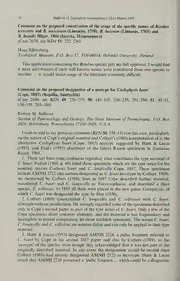
Comment on the proposed designation of a neotype for Coelophysis bauri (Cope, 1887) (Reptilia, Saurischia) PDF
Preview Comment on the proposed designation of a neotype for Coelophysis bauri (Cope, 1887) (Reptilia, Saurischia)
. 76 BullelinofZoologicalNomenclature52(1)March 1995 Comment on the proposed conservation ofthe usage ofthe specific names ofBombus ten-estris and B. muscorum (Linnaeus, 1758), B. lucorum (Linnaeus, 1761) and B. humilis Illiger, 1806 (Insecta, Hymenoptera) (Case 2638; see BZN 51: 232-236) Hans Silfverberg ZoologicalMuseum, P.O. Box 17. FIN-00014. Helsinki University Finland . ThisapplicationconcerningtheBombusspeciesgetsmyfullapproval. Iwouldfind it most u—nfortunate ifsuch well known names were transferred from one species to another it would make usage ofthe literature extremely difficult. Comment on the proposed designation ofa neotype for Coelophysis bauri (Cope, 1887) (ReptiUa, Saurischia) (Case 2840: see BZN 49: 276-279; 50: 147-151, 236-239, 291-294; 51: 48-51, 156-158, 265-266) Robert M. Sullivan Section ofPaleontology and Geology, The State Museum ofPennsylvania, P.O. Box 1026, Harrisburg, Pennsylvania 17108-1026, U.S.A. Iwishtoaddtomypreviouscomment(BZN50: 150-151)onthiscase,particularly onthenatureofCope'soriginal materialandColbert's(1989)interpretationofit,the alternative Coelophysis bauri (Cope, 1887) neotype suggested by Hunt & Lucas (1993), and Paul's (1993) placement of the Ghost Ranch specimens in Svntarsus Raath, 1969. 1 There has been some confusion regardingwhat constitutes thetypematerial of C bauri. Padian (1986, p. 46) listed those specimenswhich arethetype series forthe nominal species Coelurus bauri and C. longicollis Cope, 1887. These specimens AMNH include 2722 (the sacrumdesignated as C. baurilectotype by Colbert, 1989). As mentioned by Colbert (1989). later in 1887 Cope described further material, transferred C. bauri and C. longicollis to Tanystrophaeus, and described a third species, T. willistoni. In 1889 all three were placed in the new genus Coelophysis, of which C. bauriwas designated the type by Hay (1930). 2. Colbert (1989) synonymized C longicollis and C willistoni with C. bauri, althoughwithoutjustification. Hewronglyregardedsomeofthespecimensdescribed only in Cope's second paper as part ofthe type series ofC. bauri. Only a few ofthe Cope specimens share common elements, and the material is too fragmentary and incompleteto permitcomparison, let aloneestablish synonymy. The names C bauri, C longicollisand C. willistoniarenominadubiaandcanonlybeapplied totheirtype material. 3. Hunt & Lucas (1993) designated AMNH 2724, a pubic fragment referred to C. bauri by Cope in his second 1887 paper and also by Colbert (1989), as the 'neotype' ofthe species, even though they acknowledged that it was not part ofthe originally described material. In any event the designation would be invalid since Colbert (1989) had already designated AMNH 2722 as lectotype. Hunt & Lucas AMNH noted that 2724 possessed a 'pubic foramen ... which could be a diagnostic Bulletin ofZoological Nomenclature 52(1) March 1995 77 feature". 1 have determined that this is actually the obturator foramen, a character which is present in the holotype ofRioarribasawus colberti (AMNH 7224; personal observation), Lilienstennis liliensterni, Synfarsus rhodesiensis (Raath. 1969, p. 15, fig. 4b), and also in S. kayentakatae to which a number ofGhost Ranch specimens can be tentatively referred (personal observation). 4. There is now strong evidence (Sullivan, 1994) that suggests that the type material of C. bauri did not come from the Ghost Ranch (Whitaker) quarry. Moreover, my preliminary study of the Ghost Ranch specimens strongly suggests that two closely related yet distinct taxa (Rioarribasawus and Syntarsus) are represented there. Colbert's (1989) concept of Coelophysis bauri is most likely a composite ofthese; thiswouldexplain the unexpected morphological variation cited byhim(1989, p. 132; 1990, p. 89) amongsttheGhost Ranchtheropods. Theoriginal Cope material could belong to either. 5. Paul (1993, p. 400) recognized C. bauri as a nomen dubium. Thecharacters he (orforthat matterColbert, 1989) used to recognize Rioarribasawus(or Coelophysis) and Syntarsus are ambiguous, and Paul's synonymy of these taxa is unjustified. However, I believesomeoftheGhost Ranch specimenscanbereferred to Syntarsus; I base this onmystudies ofthe typematerial ofC. bauri, theholotype ofR. colberti, andotherspecimensinblocksattheAmerican MuseumofNaturalHistory,Carnegie Museum of Natural History, Yale Peabody Museum of Natural History and The State Museum ofPennsylvania. 6. In conclusion, (i) the type material of Coelophysis bauri (and of C. longicollis and C. nillistoni) is undiagnostic: (ii) the 'neotype designation' by Hunt & Lucas (1993) is doubly invalid; (iii) there are two distinct theropod taxa {Rioarribasawus and Syntarsus) amongtheGhost Ranch specimens, and thetypematerial ofC. bauri may belong to either. Additional references Colbert,E.H. 1990. Variation in Coelophysisbauri. Pp. 81-90inCarpenter, K. & Currie, P.J. (Eds.), Dinosaur systematics: perspectives and approaclies. Cambridge University Press, Cambridge. Hunt, A.P. & Lucas, S.G. 1993. Triassic vertebrate paleontology and biochronology ofNew Mexico. Pp. 49-60 in Lucas, S.G. & Zidek. J. (Eds.), Vertebrate paleontology in New Mexico. Bulletin2, NewMexico MuseumofNatural Historyand Science,Albuquerque. Sullivan, R.M. 1994. Topotypic material of Coelophysis bauri (Cope) and the Coelophysis- Rioarribasauriis-Syntarsus problem. P. 48A in Abstracts ofPapers. JournalofVertebrate Paleontology, 14(3)(Supplement). Comments on the proposed conservation ofthe specific name ofLiophispoecilogyrus (Wied-Neuwied, |1824|) (Reptilia, Serpentes) (Case 2875; see BZN 51; 250-252) (1) Laurie J. Witt Oklahoma Museum ofNatural History, University ofOklahoma. 1335 Asp Avenue, Norman, Oklahoma 73019-0606, U.S.A. I am in complete agreement with the application by Drs Smith, Dixon and Wallach. If one of the disused senior synonyms were introduced an incredible
